This content originally appeared on HackerNoon and was authored by Bit Staxi
\
Table of contents
Creation history
Technologies and products
2.1. Proof-of-Transfer (PoX)
2.2. Network Architecture
2.3. Stacking & Mining
2.4. sBTC
2.5. Bitcoin Name System
2.6. Clarity
2.7. Future plans
Ecosystem and development
Tokenomics
Team
Investors and finance
Activities
Results
\
1. Creation history
The Stacks project has come a long way, originating at the dawn of Bitcoin. Around the same time, when development of second-generation smart contract platforms like Ethereum and Tezos began in 2013-2014. Notably, the team has undergone two rebrandings since its inception.
\ Initially known as OneName, the project's goal was to simplify BTC transfers between addresses. They created human-readable addresses, allowing any free nickname on the network to be attached to a wallet number. This concept is similar to what the ENS (Ethereum Name Service) project developed four years later. However, OneName required linking the address to a social network profile on Facebook or Twitter. With this idea, the team entered the prestigious startup accelerator Y Combinator and secured their first round of funding.
\ The product was entirely open-source, leading to the creation of a dedicated Blockstack blockchain platform. By 2016, the team felt the OneName product was limiting their growth and began working on a new solution, prompting the rebranding to Blockstack. Although the OneName product continued to function, the team decided to pivot the company’s direction.
\ They aimed to create a separate browser based on the Bitcoin blockchain and the underlying Blockstack network. The main idea was to move user data—such as photos, messages, and meetings—to its own cloud storage, protecting it from being accessed by tech giants like Facebook, Google, and Microsoft without user permission.
\ All information was stored directly on the user’s device and could be sent to cloud storage in encrypted form, ensuring that companies could not access the data. The blockchain maintained an identification system between the user and the final resource.
\ In 2017, amidst the ICO boom and the rise of Ethereum and other new-generation blockchains, the team once again shifted the company’s direction. They decided to develop a full-fledged smart contract platform connected to the Bitcoin blockchain. This led to the creation of a new consensus algorithm called Proof-of-Burn, where BTC was used as payment for generating blocks.
\ In October 2020, the company underwent a second rebranding, focusing on brand recognition. The blockchain became known as Stacks, and the company and development team were renamed from Blockstack PBC to Hiro Systems PBC. This separation of the ecosystem and the development team has been common practice since 2020-2021.
\ In its new status, the company initiated a major update of the Stacks blockchain, called Nakamoto. This update is as significant for Stacks as Ethereum's transition to the Proof-of-Stake (PoS) consensus algorithm. The next chapter will discuss this technology in detail, with references to older versions of Stacks.
2. Technologies and products
2.1. Proof-of-Transfer (PoX)
In 2017, a significant trend emerged towards developing alternative consensus mechanisms beyond Proof-of-Work (PoW) and even Proof-of-Stake (PoS). In response, the Stacks team introduced the Proof-of-Burn (PoB) model. This innovative approach required miners on the Stacks network to send a specified amount of BTC to be burned. A Verifiable Random Function (VRF) algorithm, essentially a randomizer, would then determine which miner should be entrusted with creating a block. As per the model, the more BTC a miner burned, the higher their chances of earning the right to create a block on the Stacks network. This system was designed as an alternative to PoW, where the probability of mining a block in the Bitcoin network is determined by the miner's computational power.
\ In 2021, the team further refined the PoB consensus model, introducing a new approach that divided roles into miners and stackers:
\
- Stacks miners pay the Stacks consensus (stakers) in bitcoins for the right to create a block.
- Stakers collect these payments to a common address and randomly select a miner to process all transactions and create a block.
\ This approach effectively separated the consensus mechanism into two modules: execution and decentralized selection of the executor. This modular split mirrors the evolving practices seen in Ethereum Virtual Machine (EVM) networks. To fully understand how this consensus model is implemented, it is necessary to examine each stage step by step:
\
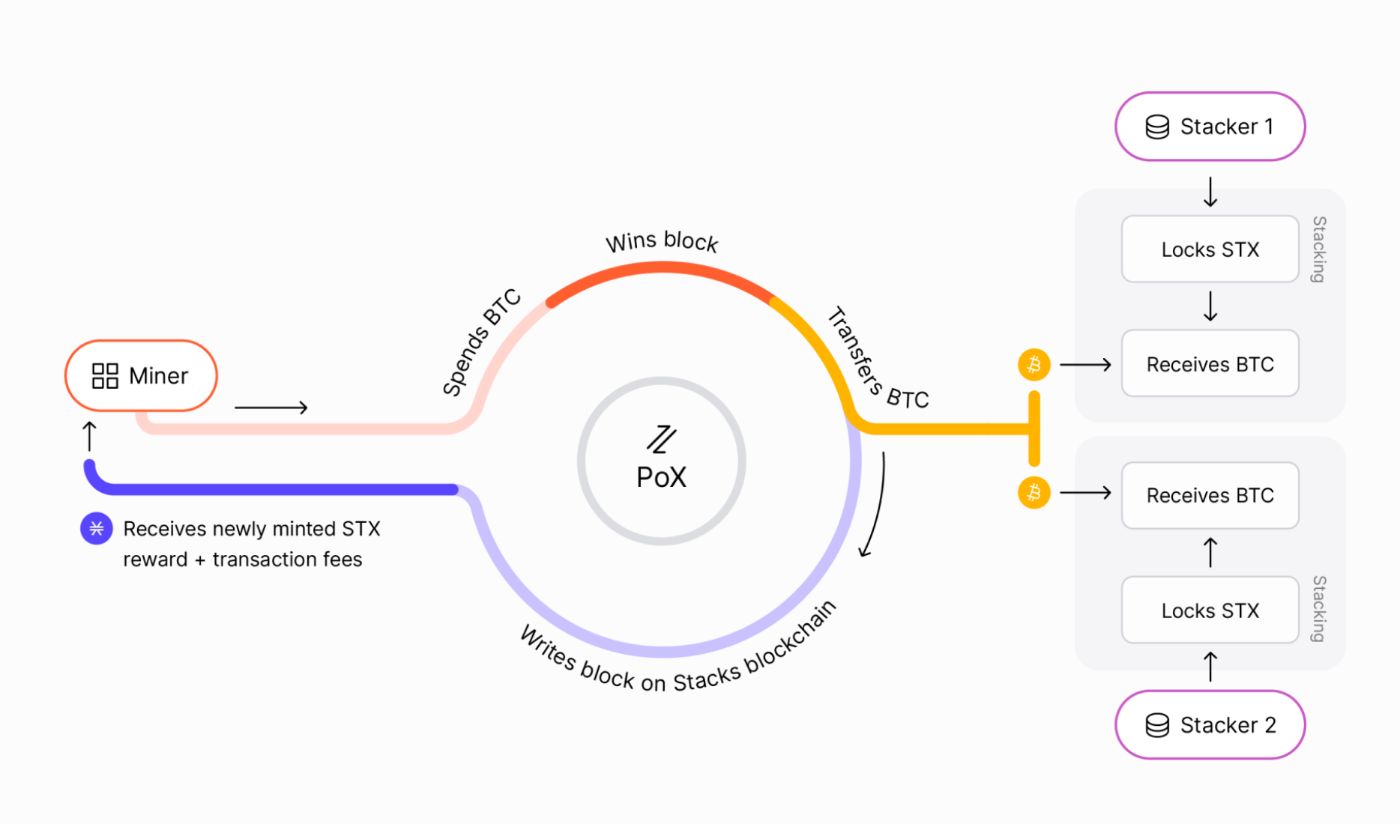
\
- A Stacks network miner must first top up their $BTC balance on the Bitcoin network.
- Next, they send the selected amount of BTC to the common address of the group of stakers, also on the Bitcoin network.
- The stakers then select the miner who should create the block based on a weighted random function. This function considers the amount of transferred BTC, similar to a lottery where the chances depend on the number of tickets. A consensus is reached when 70% of the stakers agree.
- The selected miner processes the transactions and creates a block on the Stacks network.
- After a new block is released on the Bitcoin network, the miner takes the block header (a hash function that cryptographically compresses and encrypts the block data) from the Stacks network and includes it in the Bitcoin block.
- Once the Bitcoin block containing the Stacks block hash is published on the network, the miner receives a reward in STX tokens.
\ Using this method, the Stacks network achieves the highest level of finality, primarily because the final result is published on the Bitcoin network. To roll back the Stacks network, one would need to roll back Bitcoin blocks, which is exceedingly difficult due to Bitcoin's unparalleled security and reliability in the crypto space.
\ The team implemented a unique approach where network participants receive an asset different from the one they operate on:
- Miners spend BTC and receive STX in return.
- Stakers keep STX staked but receive Bitcoin as rewards.
\ While this system might seem confusing initially, it effectively balances the value between two assets in a purely market-driven manner.
\ Additionally, this consensus model is not limited to Bitcoin; it is compatible with any other blockchains based on the Proof-of-Work algorithm. For instance, the Stacks network could be deployed as a Layer-2 solution on top of the Litecoin network.
2.2. Network Architecture
However, building a new consensus was only one step in the development of the Nakamoto update. Equally important was addressing the synchronization of transactions and blocks between the Layer-2 solution of Stacks and the Bitcoin network. The main challenge is the long block creation time of the Bitcoin network, which is approximately 10 minutes. This makes it difficult to achieve the finality and security of transactions in L2 networks built on top of Bitcoin. Additionally, there are risks of forks in such solutions.
\ To address this, the first version of Stacks had the same block length as Bitcoin. To speed up transactions, the team introduced microblocks, a parallel blockchain confirmed by the same miners. These microblocks were confirmed within a few seconds. The security of this approach relied on the same consensus, which inherently carries higher risks for transaction confirmation. This is primarily because the finality of such blocks was confirmed only by Stacks miners. Moreover, users had the option to transact either on the Stacks blockchain or through microblocks. Ultimately, this technology proved to be unclaimed and underperforming, leading to its replacement by the Nakamoto update.
\ The current architecture operates differently:
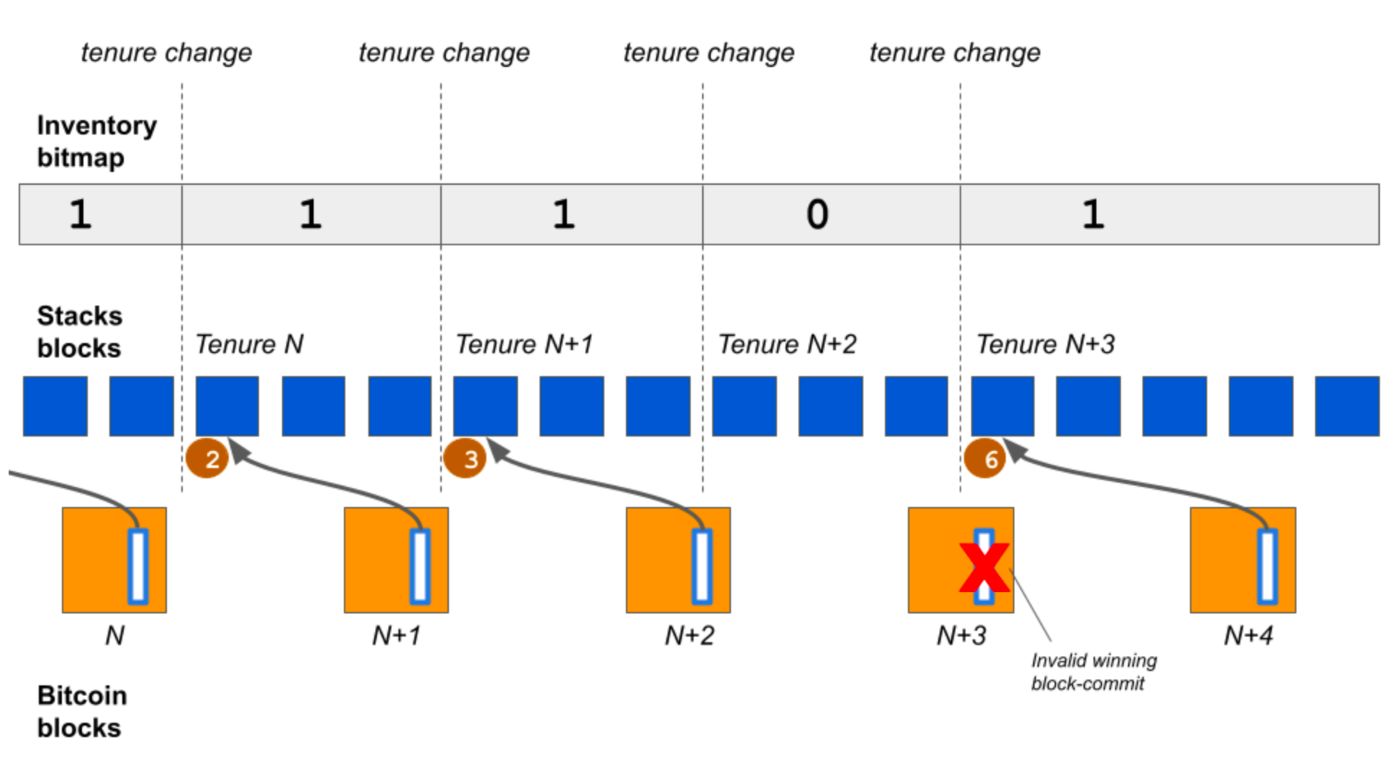
\ During the time it takes to create one Bitcoin block, a miner can create many sequentially connected blocks on the Stacks network, with each Stacks block taking approximately 5 seconds to create. When a new Bitcoin block is formed, the miner includes the header of the first Stacks block from the previous period (1 period = 1 Bitcoin block) in the Bitcoin block. Thus, the Stacks miner reports the transactions of the previous period's miner rather than their own. Before knowing who will validate the block, each miner verifies all transactions and blocks for correctness and compliance with the Stacks network's final state.
\ This method means that the Stacks network only uploads information from one of its blocks to Bitcoin. The remaining Stacks blocks are validated by miners and stakers. Since each block contains a hash of the previous one, any new block has complete information about the Stacks network. Every 10 minutes, this state is recorded by sending information from a single block to the Bitcoin network, creating anchor points that represent the Stacks network's state. This process is analogous to regular backups of digital devices, like a computer.
\ This approach significantly enhances the Stacks network's security and scalability. Attacking the Stacks network becomes as challenging as attacking Bitcoin's security. Although developers claim that Stacks has complete and equal security to Bitcoin, there are some nuances. The Stacks network started in 2020, whereas Bitcoin has been operational since 2009. This means attackers would need to alter information in the Bitcoin network from 2020 onwards, which is theoretically easier than changing data from before 2009. However, practically, Stacks' security claims are robust and close to the truth, with the concerns about partial security being more theoretical.
\ Additionally, the anchor points on the Bitcoin network make hardforks (network splits) impractical, as the network relies on Bitcoin blocks.
\ The Nakamoto update also addresses a theoretical issue with large Bitcoin miners potentially exploiting the Stacks network. Specifically, if a BTC miner is also a Stacks miner, they could prioritize including the most expensive transaction in the block during the PoB algorithm, unfairly profiting from it. Although this situation did not occur, it was possible. The update resolved this issue by reworking the randomization algorithms for selecting miners in the Stacks network, mitigating the risk of such exploits.
2.3. Stacking & Mining
On the Stacks network, the primary participants responsible for maintaining network stability are miners and stakers. Anyone with the necessary resources can become a participant. Miners need to have BTC in their accounts to pay stakers and must deploy mining software on a server. The amount of BTC required is determined by the epoch cycle, which lasts 2100 blocks. During the epoch, the average amount for each block is automatically calculated and cannot be manually adjusted. There are minimum requirements of 11,000 Satoshis ($7 at an exchange rate of $66,000) per transaction. Amounts below this threshold are considered dust and do not qualify for mining participation.
\ Stakers need to hold at least 0.02% of the circulating supply of STX tokens, roughly 300,000 coins as of May 2024, provided that the volume of staked tokens exceeds 25% of the circulating supply. If this threshold is lower, individual staking is allowed with a minimum of 75,000 STX. However, there is a common practice of delegating to staking providers if an individual does not have the required amount. Additionally, the network caps the number of stakers at 4,000; if there are more, they are ranked by their STX holdings. Penalties exist for stakers who harm the network, not through slashing (deprivation of part of the stake), but by halting their reward earnings. Once the staker resumes correct functioning and supports the network, they can earn BTC rewards again.
\ The network operates on a cycle known as an epoch, consisting of 2100 Bitcoin blocks, which takes approximately 14-15 days.

\ During the preparation phase, the network selects a pool of BTC addresses from all stakers. During this time, miners validate the correctness of the blocks and receive a list of these addresses. Once the preparation phase is complete, block confirmation begins.
2.4. sBTC
Another product from Hiro Systems (formerly BlockStack Labs) is sBTC - in simple words, it is a wrapped Bitcoin on the Stacks network. Its key difference from other alternatives, such as WBTC, RBTC (RSK/Rootstock), LBTC (Liquid Network) and others, is the open and completely decentralized system of bitcoin wrapping.
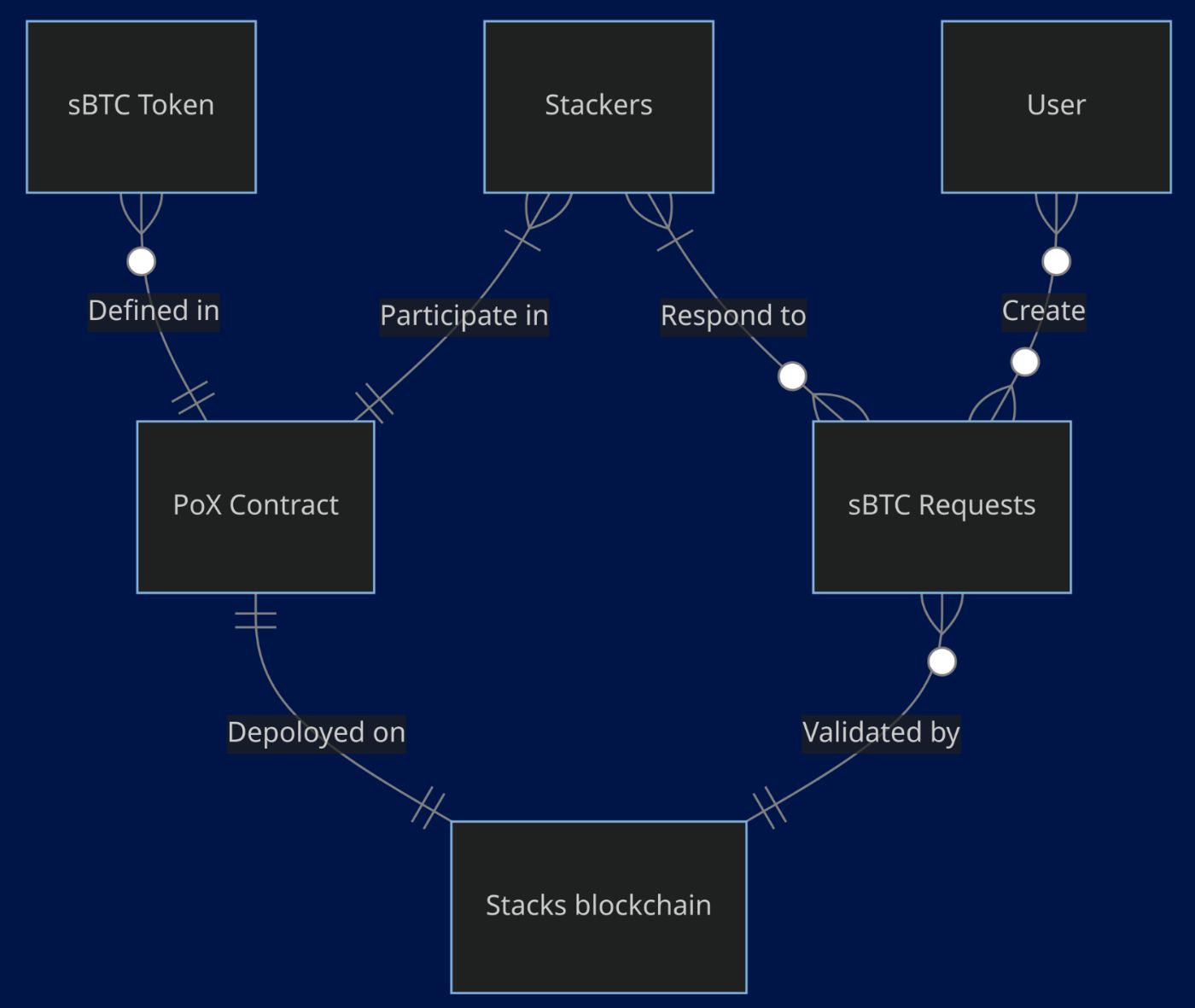
\ The protocol governing the issuance of sBTC ensures direct involvement of Stackers in the creation of wrapped Bitcoin within the same network. When a BTC flipping transaction is initiated, it is the STX staker pool that receives it. They then generate an sBTC token on Stacks and send it to the intended recipient.
\ By leveraging its own pool of validators, the team gains the advantage of inheriting the security of the Bitcoin network. Moreover, participation in sBTC is accessible to anyone simply by deploying their staker. This open system contrasts with solutions like WBTC, which is controlled by a multisig wallet of 14 signers, and other wrapped tokens that operate on limited or federated networks such as RSK, Liquid, and Threshold.
\ However, it's important to note that sBTC can only function within the Stacks network and cannot be extended to other networks. While theoretically feasible on other PoW networks, it would require a subsidiary or related network to Stacks, which are not widely adopted. Consequently, sBTC's main drawback lies in its closed ecosystem, limiting its utility beyond Stacks. While a similar approach could be applied to PoS networks, it would compromise the system's security. Mainnet launch of sBTC is planned in August 2024.
2.5. Bitcoin Name System
The domain system stands as the cornerstone of the project, marking its inception. As time progressed, the team redirected its focus towards other endeavors, relegating the BNS to a supporting role. This domain system bears striking resemblance to the classic Ethereum Name Service (ENS), meeting all standards of decentralized identification. Departing from the original concept of linking to social networks, the team forged a distinctly different product, one that severed direct ties with the Web2 realm.
2.6. Clarity
Clarity represents a novel programming language tailored specifically for the Stacks network. Designed to facilitate the creation and management of smart contracts, Clarity aims to underpin a robust ecosystem of decentralized applications (dApps).
\ The team asserts that this language offers enhanced security and addresses the shortcomings evident in Solidity, notably those implicated in the hacking incidents of Parity projects and the Ethereum network's rollback following the DAO hack in 2015. They emphasize Clarity's non-compiled nature, highlighting its fidelity to intended functionality and its developer-friendly interface for comprehension and readability.
\ Furthermore, they assert that many vulnerabilities inherent in other languages have been effectively mitigated. Notably, Clarity boasts the unique capability of interfacing with the Bitcoin network, enabling smart contracts to react dynamically to events on the Bitcoin blockchain. For instance, it can trigger a smart contract to initiate asset exchanges based on specific actions within the Bitcoin network. Unlike conventional smart contract paradigms that rely on oracles and cross-chain interactions, Clarity offers a streamlined approach that reduces the associated vulnerabilities.
\ While the true efficacy of this approach remains to be seen, as the project has yet to experience a fraction of the traffic and scrutiny endured by Ethereum, it has already produced several intricate solutions that remain largely untested.
2.7. Future plans
The team is highly proactive in advancing technologies related to Bitcoin scalability, dedicating a significant portion of their efforts to scientific and technical research in this field. They are already investigating cutting-edge technologies within the Bitcoin ecosystem, including:
\
- BitVM
- DLC (Discrete Log Contract)
- zkRollup
\ Additionally, one of Stacks' ambitious goals is to develop a comprehensive ecosystem of Layer-3 solutions on top of its network, akin to initiatives like Op Stack (Optimism), Orbit (Arbitrum), and Hyperchain (zkSync). It is clear that the project is one of the most active in the development of the Bitcoin ecosystem, continuously exploring various innovative options. Consequently, we can expect to see new technical solutions from them in the near future.
3. Ecosystem and Development
Due Stacks is primarily a Layer-2 for Bitcoin, we first need to look at its TVL:
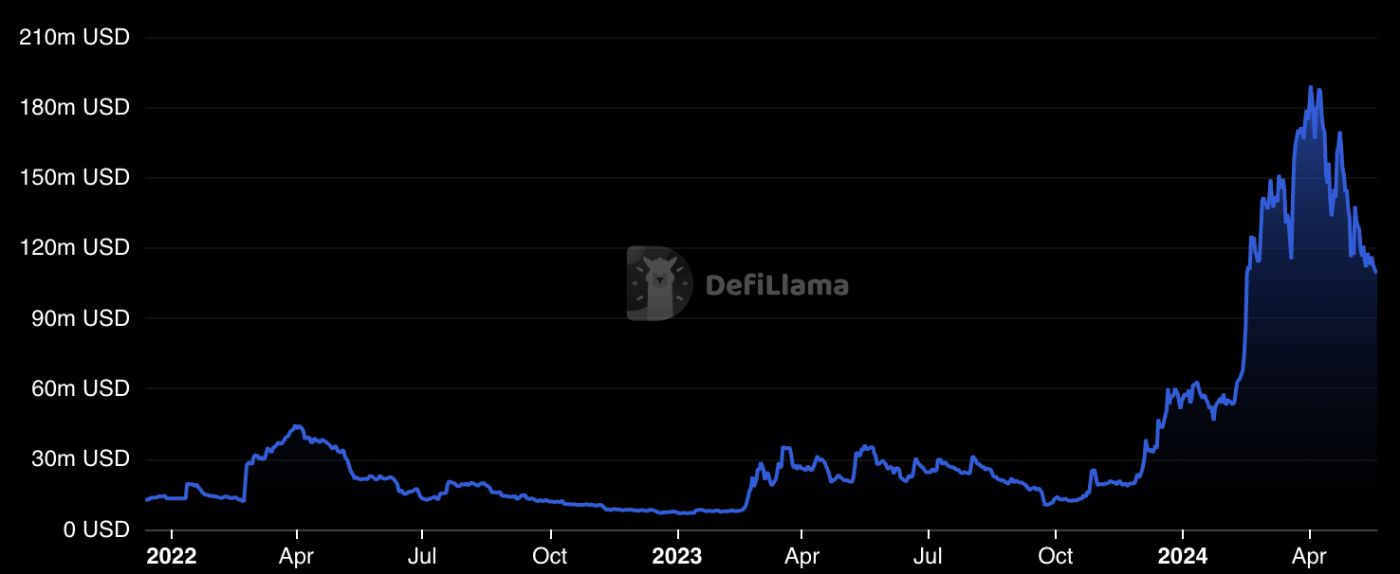
\ The amount of liquidity in the network protocols is about $100 million at the moment. In 2023, this value averaged about $30 million. Thus, the growth was more than 300%. However, most of this growth was due to the increase in the value of BTC and STX coins, since strong inflows of assets into this network have not yet been observed.
Indirectly, this is proven by statistics of user activity on the network:
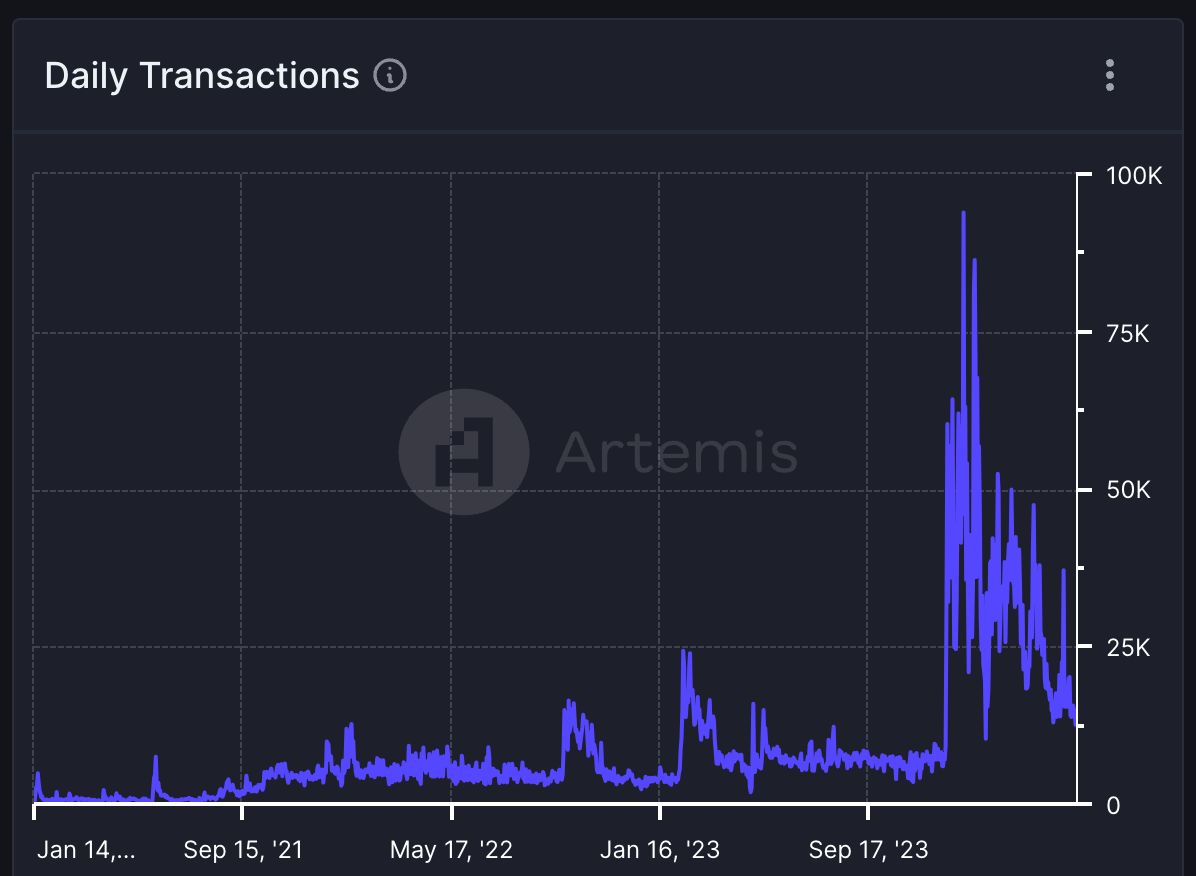
\ As can be seen from chart above, before the explosive growth at the end of 2023, the number of network transactions was about 4-5 thousand. This was followed by a sharp increase to almost 100 thousand due to the rise in the price of BTC and STX and interest in them due to the emergence of the BTC L2 narrative. Currently, this figure has dropped to 15 thousand, having adjusted by 80%.
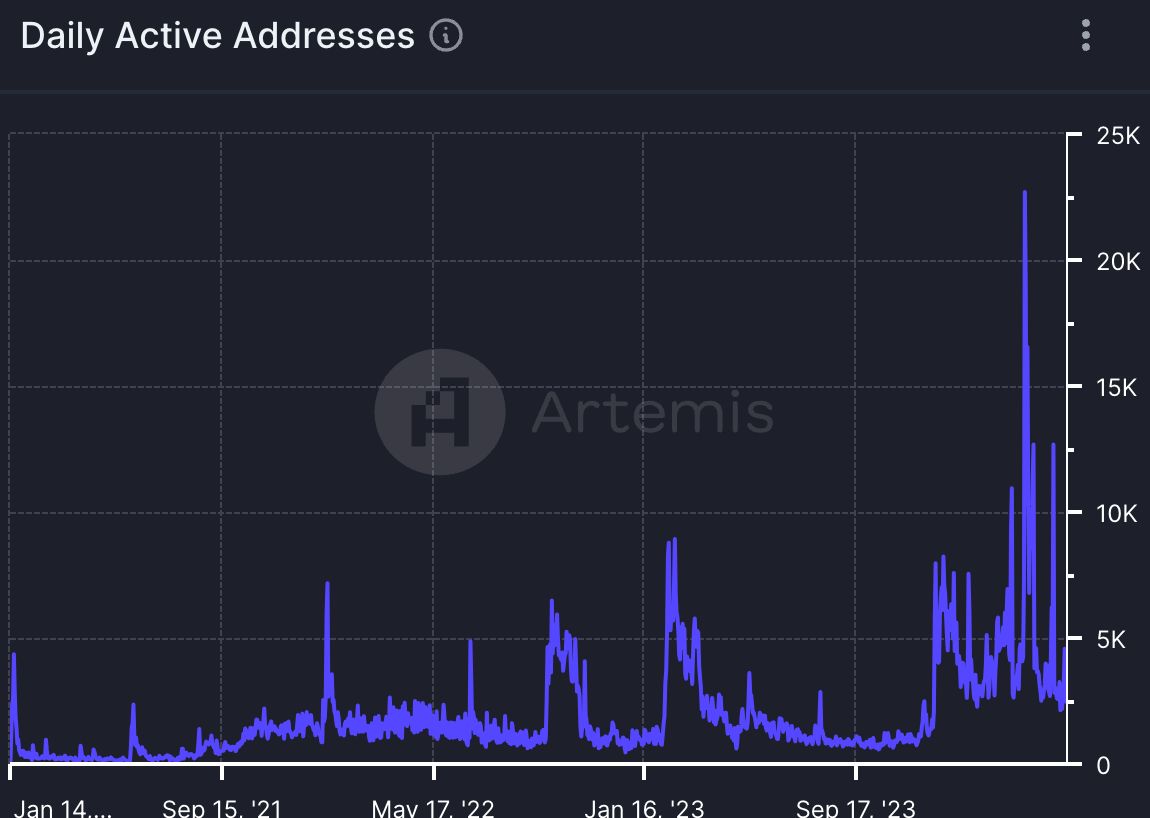
\ However, the growth in addresses/users has lagged behind the increase in transactions. This discrepancy is primarily due to individual addresses conducting multiple transactions. The dynamics of active addresses appear inconsistent, with an average of 3-4 thousand addresses utilizing the network daily. It is important to note that these statistics also include transactions related to mining and network consensus, indicating that actual end-user activity is even lower, around 20% - 25% of the total.
\ To assess whether the number of transactions on the network is significant, it helps to compare activity with other networks: Bitcoin (as the parent network), Arbitrum, Optimism, and Polygon (as Layer-2 solutions). In these networks, daily transaction volumes are in the hundreds of thousands, with the number of active addresses on the Bitcoin network alone ranging from 700 thousand to 1 million. This comparison highlights that Stacks' current user statistics are significantly lower, by hundreds of times, compared to these other networks.
\ Moreover, despite a significant increase in interest in Stacks over the past six months and the emergence of real users, the number of developers in the ecosystem has remained largely stagnant.
\
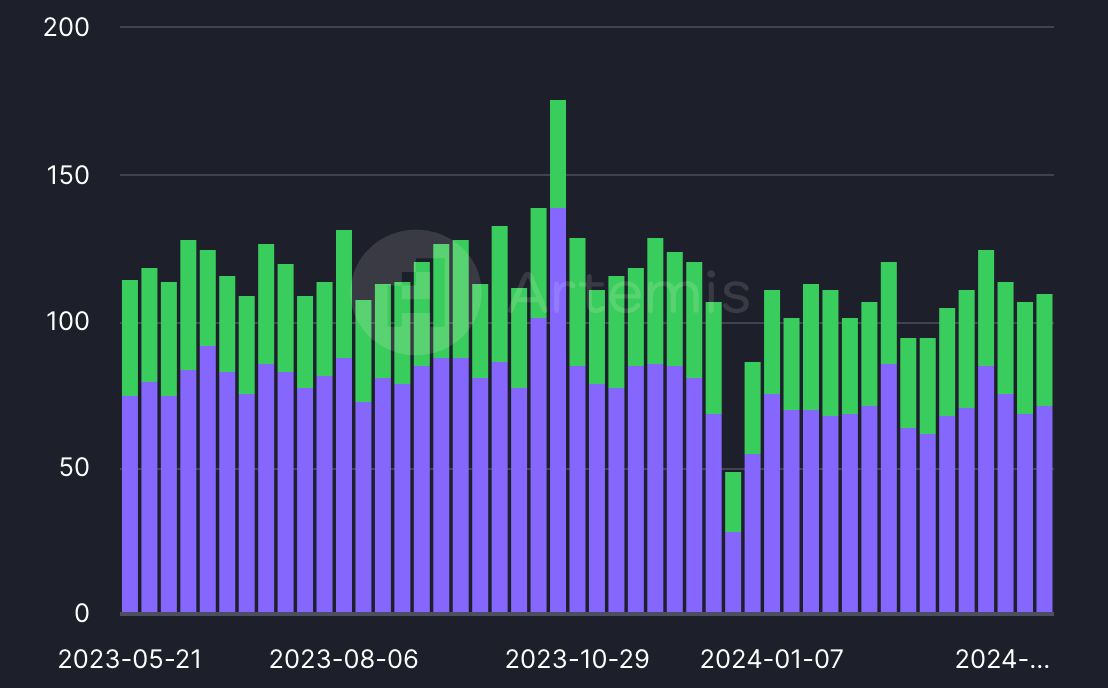
\ Moreover, there is a slight tendency towards their reduction. According to the Rootdata, there are 35 projects operating in the Stacks ecosystem. In terms of their number, this network ranks 50th in the entire market. DeFillama identifies a total of 10 projects in the DeFi sector. These are quite low figures, considering that the project comes from 2013.
\
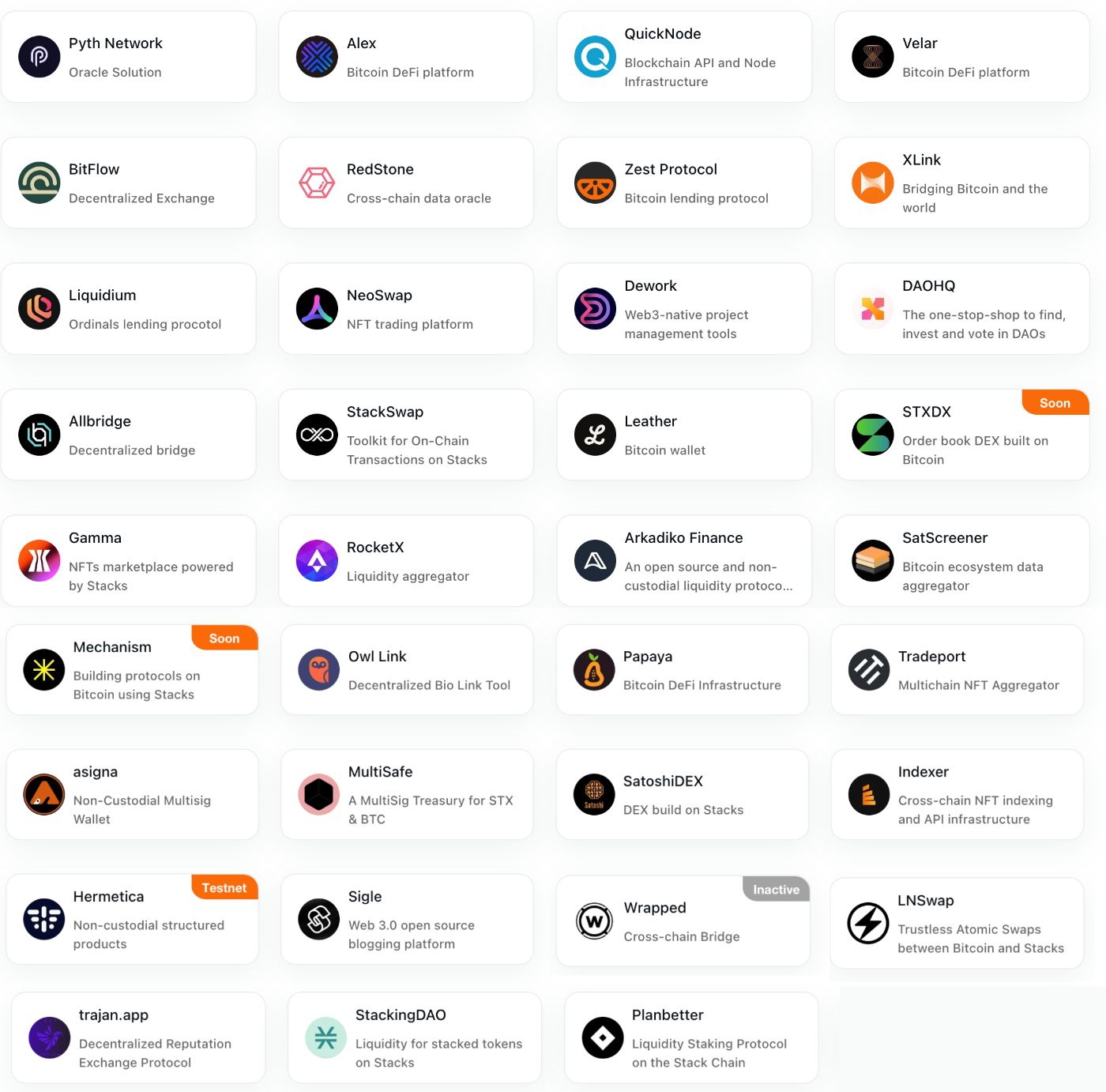
\ The sluggish growth in user dynamics is primarily a consequence of the old version of Stacks, when blocks were slower. Although the Nakamoto update addressed this issue, another significant challenge remains—the programming language. Stacks utilizes Clarity, a completely new language that requires developers to invest considerable time in learning it, a process that can take months.
\ To enhance recognition and popularity, the team actively organizes various events for developers. They host and implement programs for hackathons, grants, bug bounty initiatives, development tools, and other solutions designed to ease the onboarding process into the project ecosystem.
\ Additionally, it is interesting to examine the statistics on mining and network consensus.
\

\ The number of consensus participants ranges from 150 to 200 validators, which is a solid number for the network. This is notable considering that anyone with 75,000 STX (equivalent to $150,000 at the current rate) can become a staker. Overall, 21% of the circulating supply is already staked in the consensus.
\

\ But the number of miners looks modest. On average, 3-4 miners are engaged in mining on the network, in rare cases their number increases to 10.
\

\ On average, miners pay around 0.003 BTC per block to network validators, or ±$200. In total, 3,500 BTC or almost $250 million have been spent in the entire history of the network. Of these, 500 BTC were sent for burning under the Proof-of-Burn consensus, which were permanently removed from circulation.
\ The project is active on several social networks:
- Twitter - 200,000 followers
- Telegram - 11,000 folowers
- Discord - 40,000 followers
- Youtube - 18,000 followers
- Reddit - 9,000 followers
\
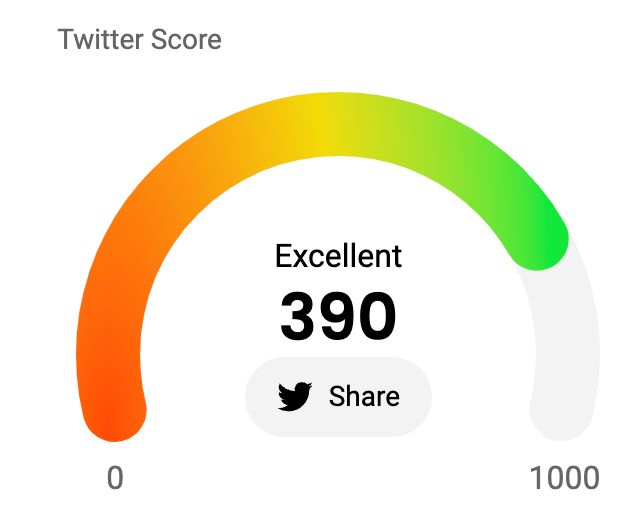
\ The team is performing admirably on social networks, attracting a significant following that includes many prominent investors and whales. Given the factors discussed, it is evident that the team is diligently working, though they face the inherent challenges of operating within the nascent Bitcoin L2 sector. Tackling this issue is complex, but they are addressing it through various programs and incentives for both the community and developers.
\ Stacks has historically focused on a problem that attracted limited interest, resulting in relatively low engagement. However, starting in 2023, this began to shift. The ecosystem, communities, and the broader Bitcoin L2 trend are all gaining momentum. The team's long-term efforts are starting to pay off, suggesting a high probability of increased activity in the coming years. Nevertheless, achieving this growth requires numerous strategic steps, and the team is actively working towards these goals.
4. Tokenomics
The Stacks network, like Bitcoin, has a halving mechanism every 4 years. In the first 4 years, 1000 STX will be mined every 10 minutes (synchronized with Bitcoin blocks). The network was launched in January 2021, so the current supply will continue until January 2025, after which it will decrease to 500 coins.
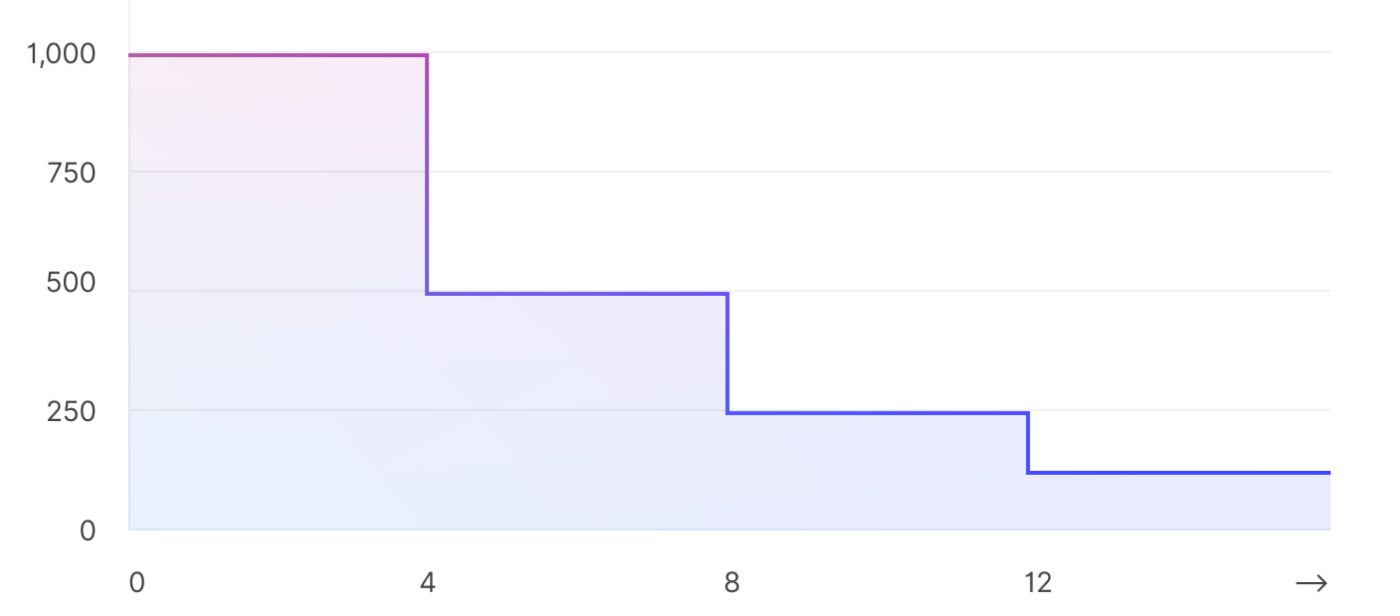
\ In total, approximately 1.818 billion coins will be mined by 2050. At the same time, in the genesis block (the moment the network was launched), 1.32 billion STX or 72.6% of the total number of coins in the future were distributed immediately. These coins were distributed among early venture investors and ICO participants. This is a pretty poor launch for the token, which ultimately led to an 85% drop in the ICO price within 4 months.
\ Over the 3.5 years of the network’s existence, 140 million STX coins were mined, or about 10% of the circulation. This means that the asset's annual inflation rate was 3%, which is an excellent indicator. Moreover, in January this value will decrease to 1.5%. The BTC inflation rate dropped to 0.8% after the halving.
\
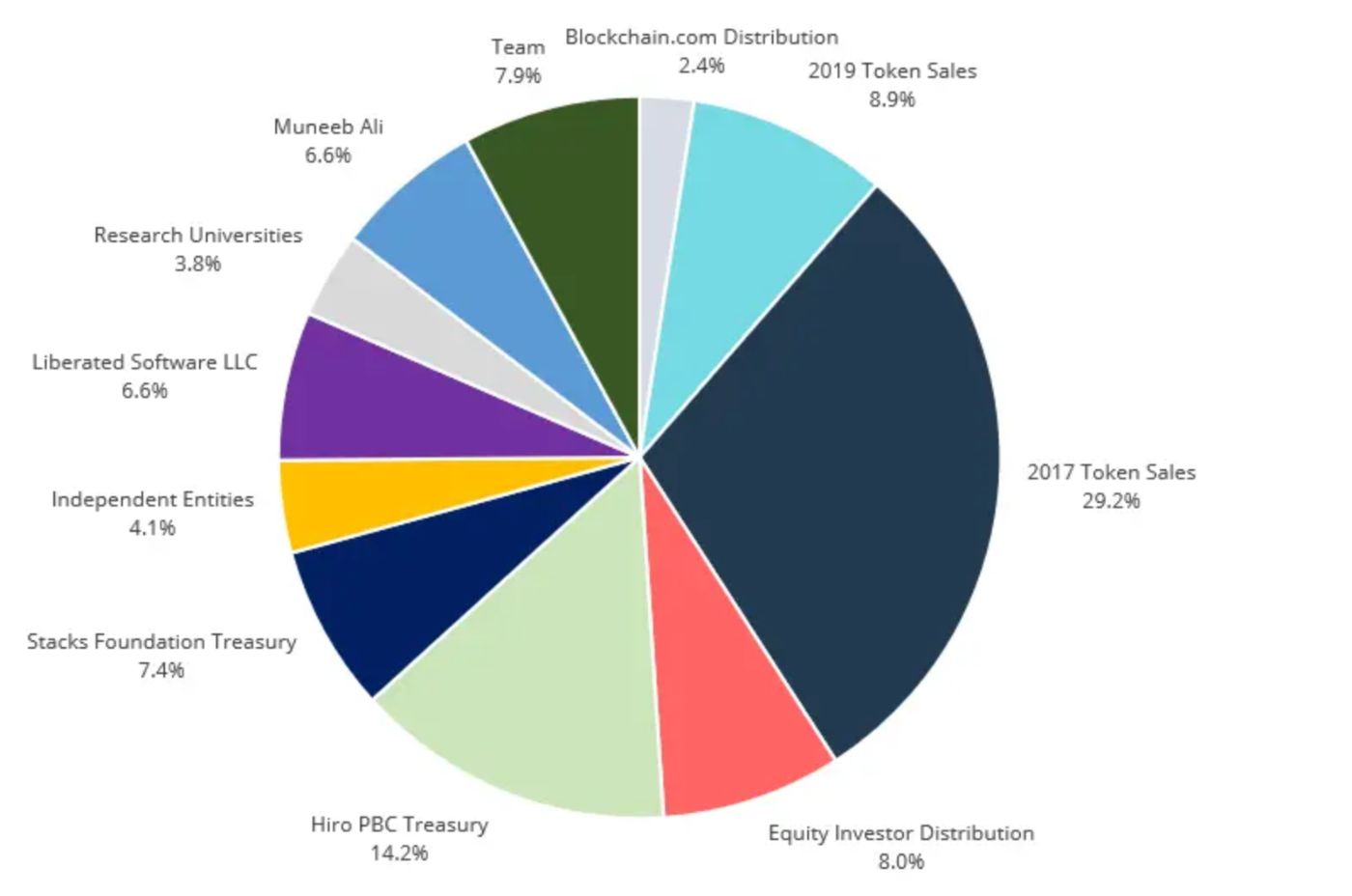
\ Examining the distribution of tokens reveals the following breakdown:
- 38.1% were sold during the Token Generation Event (TGE).
- 36.1% were allocated to the team (including Hiro PBC, Stacks Foundation, and Muneeb Ali).
- 8% were given to venture capitalists (VC).
- 17.8% were distributed among contributors.
\ The vesting periods and lockups for all categories are no longer significant due to the passage of time, as all tokens are now in the hands of their respective owners. While the initial launch and distribution might not have been ideal, the team successfully navigated this phase and continued to develop the project.
\ Main Utility Properties of the STX Token:
- Reward for miners: Miners are incentivized with STX tokens.
- Participation in PoX consensus (staking): STX tokens are used for staking in the Proof-of-Transfer (PoX) consensus.
- Use as gas: STX tokens are used to pay for transaction fees on the network.
\ This set of features for the STX token is robust, incorporating proven mechanics. The combination of both mining and staking is particularly noteworthy, as it is a challenging feat that few projects manage to execute effectively.
\ DAO Functionality:
The network also includes DAO functionality, although it is not directly tied to the STX token. A limited group of individuals, who have been involved in Stacks' development or have built projects on the network, have the authority to approve new Stacks Improvement Proposals (SIPs).
\ The tokenomics of STX have stood the test of time and have not posed problems for the project. Moreover, the strong utility properties of the STX token enable it to benefit directly from the project's growth.
\
5. Team
The Stacks project is currently quite decentralized, lacking a single team dedicated solely to its development. Although there are selected governance representatives, they rely on the research and contributions of numerous other teams. This decentralized approach mirrors how Bitcoin was created and developed during its early years.
\ Stacks was founded by Muneeb Ali in 2013. He introduced the idea of creating human-readable addresses on the Bitcoin network a decade ago and presented this project at Y Combinator. He has been instrumental in all subsequent pivots of the project. In 2017, he established a separate company, Hiro Systems, as the core contributor to the Blockstack project. Hiro Systems focused on the development and research of the Stacks network.
\ In 2022, Muneeb Ali stepped down from his role at Hiro Systems and founded a new company, Trust Machines. This company is dedicated to research and applications across the entire Bitcoin network, not just Stacks. Trust Machines is exploring new technologies and developing various dApps based on the Bitcoin blockchain.
\

\ The co-founder of the OneName project and subsequently Stacks is Ryan Shea. He worked in the project for more than 5 years and left in mid-2018. Before that, he created several startups in the field of classic IT businesses. After leaving the project, Ryan Shea began investing heavily in various projects as a business angel, taking part in investments in both Web2 and Web3 startups.
\

\ Although the early founders have already departed, their work is successfully carried on by Hiro Systems. Muneeb Ali remains a member of the board of directors at Hiro Systems, contributing to the strategic vision of the project's development. Additionally, he founded Trust Machines, a new company with a broader focus on developing applications and technologies for Bitcoin, which is crucial for Stacks itself.
\ Numerous individual developers and teams contribute to the technological advancement of the project. Notable contributors include Redstone Finance, Synonymdev, Alex Lab and Arkadiko DAO. For managing marketing initiatives and growth programs, the Stacks Foundation plays a vital role. Consequently, the Stacks network is largely self-sufficient and capable of progressing without the direct involvement of its early founders.
6. Investors and Finance
As mentioned earlier, the team received its first investment from the Y Combinator accelerator in the amount of $120,000. And just a few months later, the then OneName project closed its first seed round in the amount of $1.3 million. Even then, strong investors invested in the project, including: Union Square, Barry Silbert (Founder of DCG and Grayscale), Naval Ravikant (CEO AngelList), SV Angel.
\
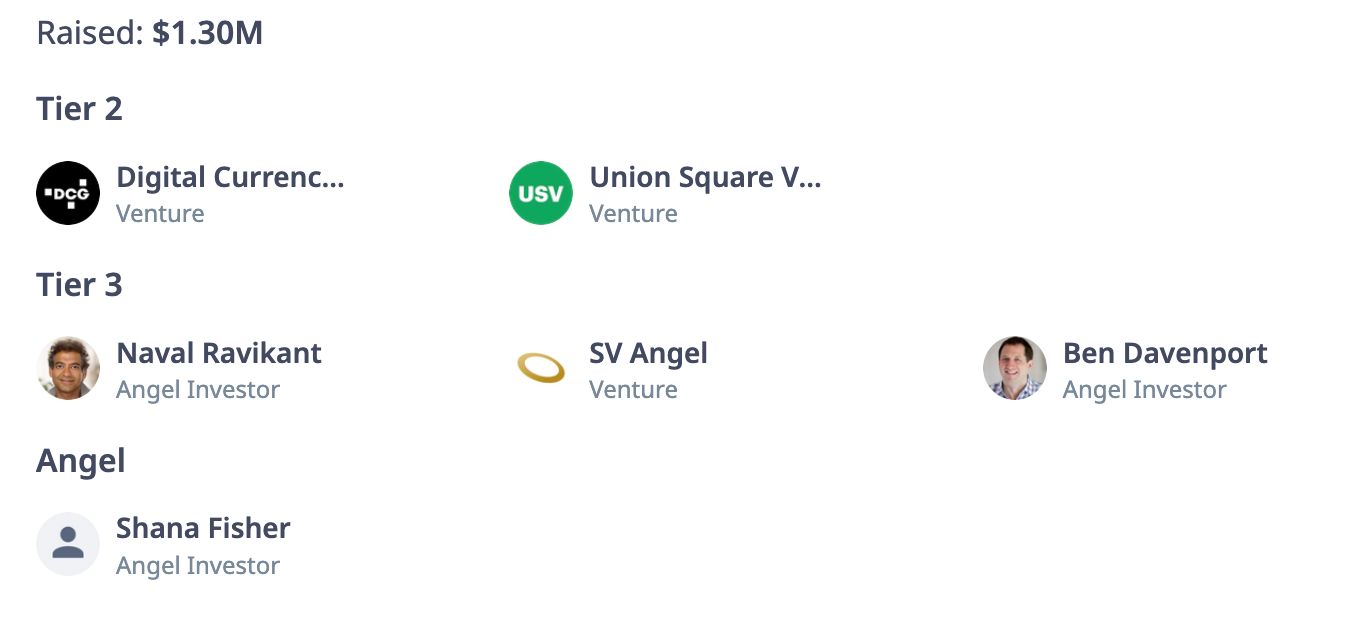
\ After 2.5 years, the team attracted new investments in a Series A round worth $4 million. Many investors from the last round joined this time - Union Square, DCG, Naval Ravikant, SV Angel. In addition, they were accompanied by other well-known funds at the moment - IOSG, Blockchain Capital - and many angels.
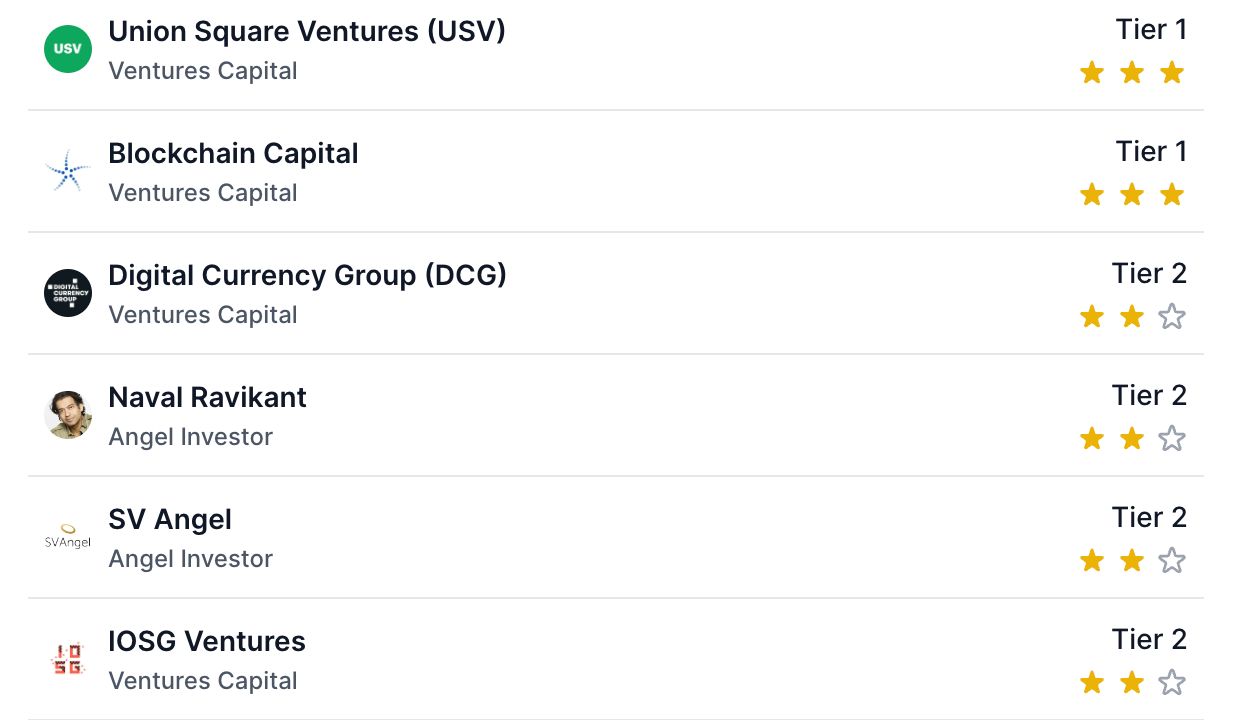
\ Almost a year later, in December 2017, the team announced a closed token sale. During it, the team raised $50 million from Tier-1 investors: Blockchain Capital, Union Square, DCG, Winklevoss Capital.

\ A year and a half later, in the summer of 2019, the team conducted the last round of investments (Strategic) from venture investors represented by Hashkey Capital, Fenbushi, Spartan, IOSG, Fundamental Labs. This was a fully SEC-licensed round, during which Security tokens were sold, and not utility tokens as was usual during ICOs. The project was able to raise $23 million in this strategic round.

\ Three months later, the company announced a public token sale on the Coinlist platform, raising an additional $18 million.
\ The team was very active in securing investment rounds, reminiscent of the standard practices of Web2 projects. This approach enabled them to raise nearly $100 million in investments alone. Investors in the Seed and Series A rounds entered the project at an STX token price of $0.019. With the current token price at $2.20, their profit exceeds 11,000%, or 110x. The subsequent rounds saw entry prices of $0.12 and $0.30. This indicates that early investors have already recouped their investments and are enjoying substantial profits.
7. Activities
Stacks offers several ways for the public to participate in the network:
\
- Become an STX Miner: This requires significant capital, around $500,000 per cycle.
- Become a Validator: You can delegate any amount to a validator and earn income in BTC, with an average return of about 3.5% APR.
- Participate in DeFi Protocols: Engage with the network's decentralized finance projects.
- Apply for a Grant: The Stacks Foundation offers grants for various projects.
\ Given the platform's importance in the BTC ecosystem, there is potential for future airdrops from various projects for staking STX.
\ A particularly noteworthy opportunity is the grant program for developers. The Stacks Foundation is making significant efforts to attract developers to its ecosystem to build various applications. They are especially interested in projects related to their key products: Nakamoto, sBTC, and Clarity. With the Foundation's support, you can start working on your project successfully. They offer not only financial support but also networking opportunities with key industry figures, strategic assistance, and acceleration programs.
Results
- The project has undergone a remarkable evolution, transitioning from a domain service on Bitcoin in 2013 to becoming a pivotal player in the Bitcoin Layer 2 (L2) ecosystem.
- The team has displayed adaptability by radically altering their product concept multiple times, ultimately discovering tangible applications that benefit society.
- With a strong team of researchers and developers, Stacks is recognized as one of the core contributors to Bitcoin technologies.
- The recent Nakamoto update represents a significant leap forward, elevating the network to a new technical standard and simplifying user interaction from a technical standpoint.
- Unique technologies like the Proof-of-Transfer (PoX) consensus algorithm and sBTC are distinguishing features of the project.
- Despite relatively low current network activity, recent months have seen a notable uptick, prompting proactive efforts from the project team to attract developers through grants, residencies, and other programs.
- The project operates under a self-governing model, underpinned by a robust management and development structure that enables founders to transition to other projects confidently.
- Early support from strong investors has fortified the project's financial outlook, instilling confidence in its future trajectory.
- With a total capitalization of approximately $4 billion, equivalent to 0.29% of Bitcoin's capitalization, Stacks holds a significant position within the broader crypto landscape. By comparison, leading Layer-2 solutions on Ethereum, such as Optimism, Arbitrum, and Starknet, collectively represent about 2.7% of Ethereum’s capitalization, with an average valuation of $12 billion.
- As interest in Bitcoin L2 solutions continues to surge, the Stacks network is poised to gain further prominence as a leading solution within the Bitcoin ecosystem.
\ \
Research prepared by Bit Staxi
\ \
This content originally appeared on HackerNoon and was authored by Bit Staxi
Bit Staxi | Sciencx (2024-06-26T19:36:57+00:00) What the Heck Is Stacks? An Indepth Look Into One of the Largest L2 in the Bitcoin Ecosystem. Retrieved from https://www.scien.cx/2024/06/26/what-the-heck-is-stacks-an-indepth-look-into-one-of-the-largest-l2-in-the-bitcoin-ecosystem/
Please log in to upload a file.
There are no updates yet.
Click the Upload button above to add an update.
